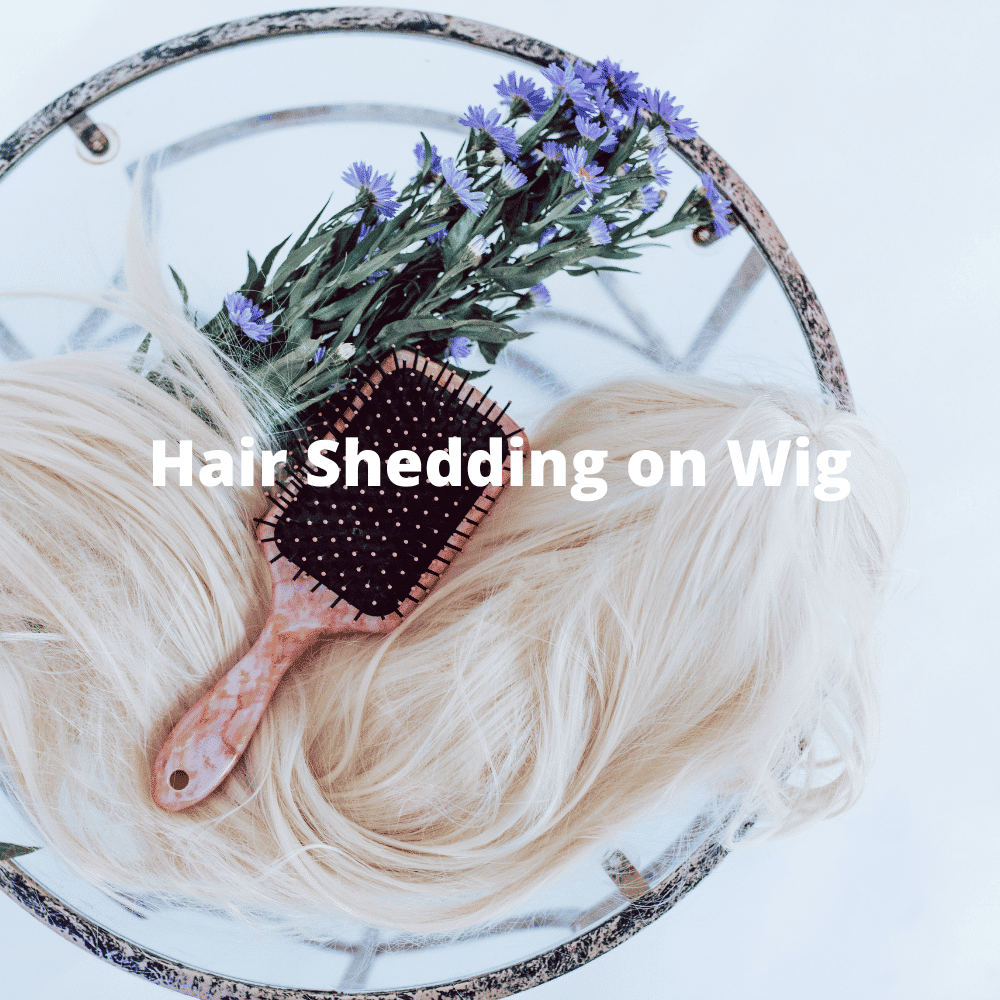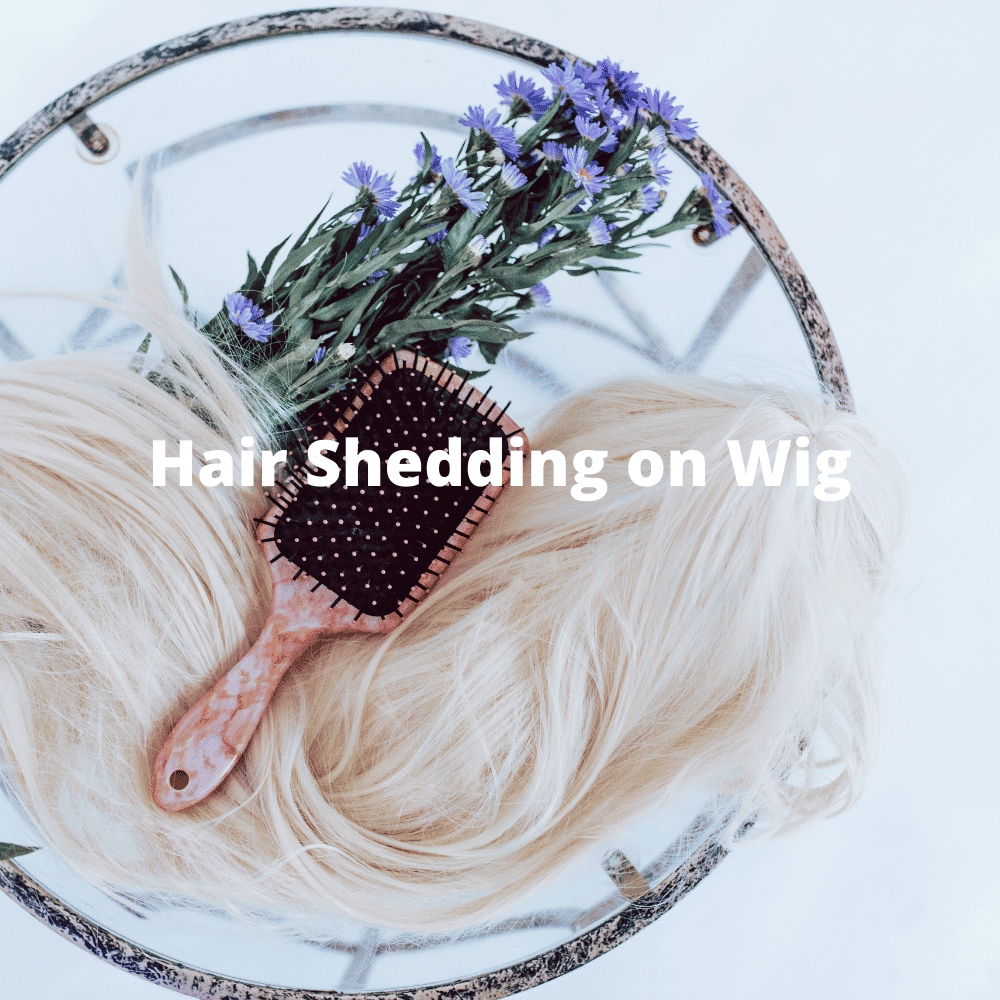Have you ever wondered how to deal with shedding in your human hair wig? Shedding can be a common issue, and it can be frustrating when you find strands of hair coming loose from your wig. But fear not! In this article, we’ll discuss some tips and tricks to help you manage and reduce shedding in your human hair wig.
Shedding in a human hair wig can occur for various reasons. One possible cause is excessive brushing or combing, which can lead to hair strands being pulled out. To minimize shedding, it’s essential to handle your wig with care and use a wide-toothed comb or a wig-specific brush when styling or detangling. Another factor that can contribute to shedding is the quality of the wig itself. Investing in a high-quality human hair wig can greatly reduce shedding, as these wigs are made from healthy, strong hair strands.
Proper maintenance is key when it comes to reducing shedding in your human hair wig. Regularly washing and conditioning your wig with products specifically designed for human hair wigs is crucial. It’s important to avoid using harsh products or techniques that can damage the hair. Additionally, avoiding excessive heat styling and opting for heat protectant sprays can help preserve the integrity of the hair strands and prevent shedding.
When it comes to styling your human hair wig, it’s important to be gentle and avoid putting too much strain on the hair. Avoid tight hairstyles or pulling the hair too tightly when styling, as this can cause stress on the hair strands and lead to shedding. Additionally, using a wig cap or adhesive can help secure the wig in place and prevent excessive movement, which can also contribute to shedding.
In this article, we’ve covered some tips and tricks to help you deal with shedding in your human hair wig. By handling your wig with care, choosing a high-quality wig, and following proper maintenance and styling techniques, you can minimize shedding and enjoy your wig for longer. For more in-depth information and guidance, be sure to check out our article on how to deal with shedding in a human hair wig. Shedding is a common concern for those who wear human hair wigs. While some shedding is normal, excessive shedding can be frustrating and may affect the overall appearance and durability of the wig. In this article, we will discuss the causes of shedding in human hair wigs, differentiate between normal and excessive shedding, explore why shedding occurs, and provide tips and techniques to prevent and minimize shedding. Additionally, we will discuss how to repair and restore a shedding wig, alternative solutions for shedding wigs, and the importance of seeking professional guidance.
Causes of Shedding in Human Hair Wigs
Shedding in human hair wigs can occur due to several reasons. Understanding these causes is essential in effectively dealing with shedding. Some common causes of shedding in human hair wigs include:
-
Normal Wear and Tear: Just like natural hair, human hair wigs undergo a natural shedding process. The wear and tear of daily usage can cause some hair strands to shed. This is considered normal shedding and should not be a cause for concern.
-
Tangling and Maintenance Issues: Improper maintenance, harsh brushing, and neglecting to detangle the wig regularly can lead to excessive shedding. Knots and tangles can cause the hair strands to break and shed more easily.
-
Poor Quality or Damaged Hair: Human hair wigs made with low-quality or damaged hair strands are more prone to shedding. When purchasing a human hair wig, it is important to ensure that the hair used is healthy and of good quality.
-
Chemical Treatments: Excessive use of harsh chemical treatments such as hair dyes, relaxers, and perming solutions can weaken the hair strands and cause shedding.
Normal Shedding vs Excessive Shedding
It is important to differentiate between normal shedding and excessive shedding in human hair wigs. Normal shedding refers to the natural shedding process that occurs in human hair wigs and is considered to be within acceptable limits. On the other hand, excessive shedding refers to hair loss that is beyond what is considered normal and may require attention and intervention.
Normal shedding in human hair wigs can range from a few strands to a small handful. The shedding may be more noticeable during brushing or styling, but it should not be excessive or cause bald patches.
Excessive shedding, on the other hand, involves a significant amount of hair loss. This can be observed by large clumps of hair coming out during brushing, frequent tangling, and noticeable thinning of the wig. Excessive shedding may be a sign of poor quality hair, improper maintenance, or other underlying issues.
Why Does Shedding Occur in Human Hair Wigs?
Understanding the factors that contribute to shedding in human hair wigs can help prevent and minimize the issue. Shedding occurs due to several reasons, including:
-
Hair Cuticles: Human hair wigs have cuticles, which are the protective outer layer of the hair strand. If the cuticles are not properly aligned, they can catch and tangle with each other, leading to shedding.
-
Weft Construction: The weft, which is the base of the wig, is sewn together using thread. If the weft is poorly constructed or the thread is not secure, it can cause the hair strands to loosen and shed.
-
Chemical Treatments: Exposure to excessive heat, harsh chemicals, and improper hair care products can weaken the hair strands, making them more prone to shedding.
-
Stress and Friction: Rough handling, pulling, and brushing the hair excessively can cause stress and friction on the hair strands, resulting in shedding.
Preventing Shedding in Human Hair Wigs
While shedding is a natural process, there are several measures you can take to prevent and minimize shedding in your human hair wig. By following proper care and maintenance techniques, choosing the right products, and adopting gentle styling methods, you can maintain the longevity and quality of your wig. Here are some tips to prevent shedding:
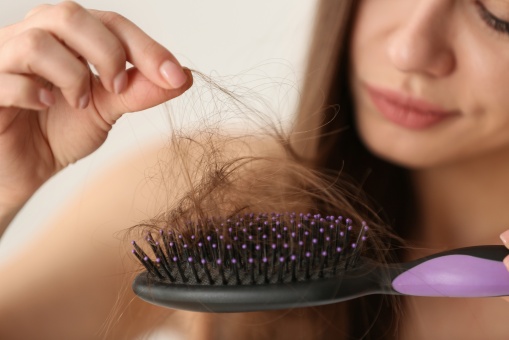
Proper Care and Maintenance
Choosing the Right Products for Your Human Hair Wig
When it comes to caring for your human hair wig, using the right products is crucial. Opt for sulfate-free and alcohol-free shampoos and conditioners specifically formulated for human hair wigs. These products are gentle and help to maintain the integrity of the hair strands without stripping away natural oils.
Avoid using regular hair care products designed for natural hair, as they may contain harsh chemicals that can damage the wig. Additionally, avoid products with a high alcohol content, as they can dry out the hair and cause shedding.
Washing and Conditioning Your Wig
Regular washing and conditioning are essential to maintain a healthy and shed-free wig. Aim to wash your wig every 7-10 wears or as needed, depending on the amount of product build-up or exposure to environmental factors.
Start by gently detangling the wig using a wide-tooth comb or your fingers. Wet the wig with lukewarm water and apply a small amount of shampoo, working it into a lather. Gently massage the shampoo into the hair strands, being careful not to rub or twist them excessively.
Rinse the wig thoroughly with cool water, ensuring that all shampoo residue is removed. Apply a generous amount of conditioner, focusing on the mid-lengths and ends of the hair strands. Allow the conditioner to sit for a few minutes before rinsing it out with cool water.
Avoid rubbing or wringing the wig vigorously as this can cause tangling and shedding. Instead, gently squeeze out the excess water and blot the wig with a clean towel to remove any remaining moisture. Allow the wig to air dry on a wig stand or mannequin head to maintain its shape and prevent tangling.
Detangling Techniques
Regular detangling is important to prevent matting and tangling, which can lead to shedding. Start by gently combing through the wig using a wide-tooth comb or a brush specifically designed for wigs. Begin at the ends of the hair strands and work your way up to the roots, using small, gentle strokes.
Avoid pulling or tugging on the hair strands, as this can cause breakage and shedding. If you encounter a knot or tangle, use your fingers or a wide-tooth comb to gently separate the hair strands, working from the bottom up.
To further prevent tangling, consider applying a small amount of leave-in conditioner or a detangling spray to the hair strands. This will help to keep the hair smooth and manageable, reducing the risk of shedding during the detangling process.
Storing Your Wig to Prevent Shedding
Proper storage is essential to prevent shedding and maintain the longevity of your human hair wig. When not in use, store your wig on a wig stand or mannequin head to preserve its shape and prevent tangling.
Before storing the wig, ensure that it is clean and completely dry. Comb through the hair strands to remove any tangles or knots, and gently twist the hair into a loose bun or braid to prevent tangling during storage.
Place the wig on a wig stand or mannequin head, making sure that the hair is not compressed or crushed. Cover the wig with a wig net or breathable fabric to protect it from dust and other environmental factors.
Avoid storing your wig in direct sunlight or in humid areas, as this can damage the hair and contribute to shedding. Instead, choose a cool, dry location away from heat sources and extreme temperature fluctuations.
Styling Techniques to Minimize Shedding
Avoiding Heat Damage
While human hair wigs offer the advantage of heat styling, excessive heat can cause damage and contribute to shedding. Minimize the use of heat styling tools such as straighteners, curling irons, and hairdryers to prevent heat-related damage.
When using heat styling tools, ensure that they are set to a low or medium heat setting. Apply a heat protectant spray or serum to the hair strands before styling to provide a barrier against heat damage.
Avoid applying excessive heat to the same area of the wig repeatedly, as this can weaken the hair strands and cause shedding. Instead, use a wide-tooth comb or your fingers to gently style and shape the wig, minimizing the need for excessive heat styling.
Using Gentle Styling Tools
Choosing the right styling tools can go a long way in minimizing shedding in your human hair wig. Opt for wide-tooth combs or brushes specifically designed for wigs, as they are gentler and less likely to cause damage or breakage.
Avoid using brushes or combs with sharp or harsh bristles, as they can snag and pull on the hair strands, contributing to shedding. When detangling or styling your wig, work in small sections and use gentle, downward strokes to minimize friction and reduce the risk of shedding.
Applying and Removing Styling Products
When applying styling products to your human hair wig, use a light hand and avoid applying products directly to the roots or wefts. Excessive product buildup can weigh down the hair and contribute to shedding.
For styling products such as hairspray or mousse, apply a small amount to your hands and distribute it evenly throughout the hair strands, focusing on the mid-lengths and ends. This will help to enhance the hairstyle without causing excessive product buildup.
When removing styling products from your wig, gently brush through the hair strands to remove any product residue. Avoid using harsh chemicals or solvents to remove stubborn product buildup, as this can damage the hair and cause shedding.
Protective Styling Methods to Reduce Shedding
Consider adopting protective styling methods to minimize shedding in your human hair wig. Protective styles such as braids, buns, or updos can help to protect the hair strands from daily wear and tear, reducing the risk of shedding.
Before styling your wig into a protective style, ensure that the hair is clean, dry, and thoroughly detangled. Use gentle styling techniques and avoid pulling or tugging on the hair strands excessively.
Avoid using tight or restrictive hairstyles, as this can cause tension and stress on the hair, leading to shedding. Instead, opt for loose and comfortable styles that allow the hair to breathe and move naturally.

Repairing and Restoring a Shedding Wig
Identifying and Repairing Weak or Damaged Hair Strands
If you notice weak or damaged hair strands in your wig, it is important to address the issue promptly to prevent further shedding. Start by identifying the weak or damaged areas by gently examining the hair strands.
Once identified, use a small pair of scissors to carefully trim the weak or damaged ends. Be cautious not to cut too much hair, as this can result in an uneven appearance.
After trimming, apply a small amount of hair oil or serum to the ends of the hair strands to provide moisture and promote strength and elasticity. This will help to prevent future breakage and shedding.
Reinforcing the Wig Cap
The wig cap plays a crucial role in the stability and security of your wig. If the wig cap is loose or damaged, it can contribute to shedding and make the wig less secure on your head.
To reinforce the wig cap, start by inspecting the cap for any looseness or damage. If the cap is loose, consider adding adjustable straps or wig clips to provide a more secure fit.
If the cap is damaged or has stretched out over time, it may need to be repaired or replaced. Consult with a wig specialist or a professional wig repair service to determine the best course of action.
Adding New Hair Strands to Combat Shedding
In some cases, adding new hair strands to your wig may be necessary to combat shedding. This is particularly useful for wigs with thinning areas or noticeable bald patches.
To add new hair strands, you can either opt for professional help or attempt the process yourself. If you choose to do it yourself, start by selecting hair strands that closely match the color, texture, and length of your existing wig.
Using a small crochet needle or a ventilating needle, carefully weave the new hair strands into the wig cap, ensuring a secure and natural-looking attachment. Take care not to cause further damage or tangling during this process.
Adding new hair strands should be approached with caution and precision. If you are unsure or uncomfortable with the process, it is always best to seek professional help to ensure the best results.
Seeking Professional Help for Wig Repairs
If your human hair wig continues to shed despite your best efforts, it may be time to seek professional help. Professional wig repair services can provide specialized solutions for shedding wigs, addressing specific issues and restoring the quality and appearance of your wig.
A professional wig repair service can assess the condition of your wig, identify the underlying causes of shedding, and recommend appropriate repairs and treatments. They have the expertise and tools to refine and strengthen your wig, ensuring that it remains shed-free and long-lasting.
When choosing a professional wig repair service, look for experienced and reputable providers. Check their credentials, read reviews or testimonials, and consult with them about their repair process and pricing structure. It is important to choose a service that understands your specific needs and can provide tailored solutions for your shedding wig.
Additional Tips and Tricks
Regular Maintenance Schedule
Establishing a regular maintenance schedule for your human hair wig is crucial to preventing shedding. Set aside time each week or as needed to properly care for your wig, ensuring that it remains clean, detangled, and well-maintained.
A regular maintenance schedule may include washing and conditioning the wig, detangling, styling, and inspecting the wig for any signs of shedding or damage. By incorporating these tasks into your routine, you can stay on top of the wig’s condition and prevent shedding issues before they escalate.
Avoiding Rough Handling of the Wig
Gentle handling is key to minimizing shedding in your human hair wig. Avoid rough or aggressive handling, pulling, or tugging on the hair strands, as this can cause stress and friction, leading to shedding.
When putting on or removing the wig, do so with care and gentle movements. Hold the wig by the cap or base and avoid pulling or stretching the hair strands.
Avoid brushing or combing the wig forcefully, as this can damage the hair and contribute to shedding. Instead, opt for gentle brushing techniques using wide-tooth combs or brushes specifically designed for wigs.
Protecting the Wig During Sleep
Protecting your human hair wig during sleep can help to prevent tangling, matting, and shedding. Before going to bed, consider wrapping your wig in a silk or satin scarf or using a silk or satin pillowcase.
Silk and satin are smooth and gentle materials that reduce friction and prevent the hair strands from catching or tangling during sleep. This can help to maintain the integrity of the wig and minimize shedding.
Avoid going to bed with a wet wig, as this can lead to tangling and matting. Ensure that your wig is completely dry before wrapping or covering it for sleep.
Avoiding Excessive Tension on the Wig
Excessive tension on the wig can cause stress on the hair strands and contribute to shedding. Avoid tight hairstyles, such as high ponytails or tightly braided styles, as they can exert unnecessary tension on the wig.
Instead, opt for loose and comfortable hairstyles that allow the hair to move naturally. Consider using soft hair ties or clips that do not pull or tug on the hair strands. This will help to minimize tension and reduce the risk of shedding.
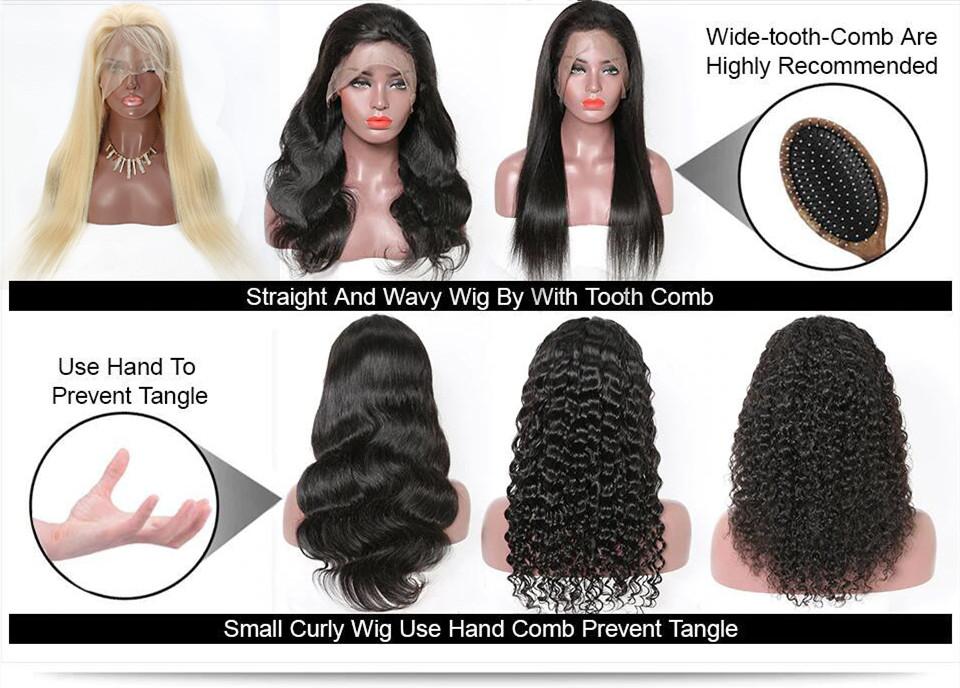
Alternative Solutions for Shedding Wigs
Exploring Different Wig Construction Types
If you are consistently experiencing shedding issues with your human hair wig, it may be worth exploring alternative wig construction types. There are various construction types available, each with its unique features and benefits.
Lace front wigs, for example, have a sheer lace material at the front that creates a natural-looking hairline. This construction type offers a secure fit and reduces the risk of shedding along the hairline.
Full lace wigs, on the other hand, have a lace cap that covers the entire head, allowing for versatile styling and a natural appearance. They are generally more expensive but provide maximum comfort and flexibility.
By exploring different wig construction types, you may find a design that better suits your needs and minimizes shedding.
Considering Non-Human Hair Wigs
If shedding remains a persistent issue despite your efforts, you may consider exploring non-human hair wigs as an alternative. Synthetic wigs and blended wigs (a combination of human and synthetic hair) are available in a variety of styles and colors, providing an alternative solution for shedding concerns.
Synthetic wigs are often pre-styled and require minimal maintenance. They are generally more affordable and can withstand various weather conditions without losing their style or shape.
Blended wigs offer the best of both worlds by combining the durability and natural appearance of human hair with the low-maintenance and affordability of synthetic hair.
While non-human hair wigs may not offer the same level of realism and versatility as human hair wigs, they can be a viable option for those struggling with shedding issues.
Temporary Alternatives to Wigs
If shedding continues to be a problem, you may consider temporary alternatives to wigs. These alternatives offer a break from traditional wig wearing while still providing coverage and style options.
Headscarves, turbans, and hats are popular temporary alternatives that can be worn to cover the head and provide a fashionable and chic look. They come in various colors, patterns, and styles, allowing you to express your personal style and enhance your confidence.
Temporary alternatives can be especially useful during warm weather or as a temporary solution while addressing shedding issues with your wig.
Seeking Professional Guidance
Consulting with a Wig Specialist
If shedding in your human hair wig continues to be a concern, consider consulting with a wig specialist. Wig specialists have in-depth knowledge and expertise in the field of wigs and can provide personalized advice and solutions.
A wig specialist can assess the condition of your wig, identify any underlying issues, and recommend appropriate techniques or treatments to minimize shedding. They can also offer guidance on wig selection, customization, and care, ensuring that you have all the information and support you need to effectively deal with shedding.
When choosing a wig specialist, look for professionals who are experienced, knowledgeable, and have a good reputation. Ask for recommendations from friends or online wig communities, and do thorough research before making your decision.
Visiting a Hair Stylist Experienced in Wig Maintenance
Another option is to visit a hair stylist who is experienced in wig maintenance. Hair stylists who specialize in wig maintenance can provide expert advice and perform advanced techniques to address shedding issues.
Hair stylists experienced in wig maintenance can assess the condition of your wig, provide professional trimming, and suggest appropriate treatments or repairs. They can also offer guidance on styling techniques and recommend products that are suitable for your wig.
Ensure that the hair stylist you choose has experience working with wigs and understands the specific needs of human hair wigs. Communication is key, so make sure to clearly communicate your concerns and expectations to ensure the best results.
Joining Online Wig Communities for Advice and Support
Joining online wig communities can be a valuable resource for advice, support, and guidance in dealing with shedding issues. There are various online forums, social media groups, and websites dedicated to wig wearers, where you can connect with others who have similar experiences.
These communities provide a platform to share your concerns, ask questions, and seek advice from experienced wig wearers or professionals. You can gain insight into different techniques, products, and solutions that have worked for others dealing with shedding in human hair wigs.
When participating in online wig communities, it is important to exercise caution and verify the reliability of the information provided. Look for reputable sources, read reviews or testimonials, and consult with professionals to ensure that you are receiving accurate advice and recommendations.
Attending Wig Care Workshops
Attending wig care workshops can offer hands-on learning opportunities and expert guidance in dealing with shedding issues. These workshops are often conducted by wig specialists or hair stylists experienced in wig maintenance and provide valuable insights into proper care, maintenance, and repair techniques.
Wig care workshops cover a range of topics, including washing and conditioning, detangling methods, styling techniques, and repairing shedding wigs. They offer a platform to ask questions, receive personalized advice, and gain practical skills in caring for your wig.
Check local hair salons, beauty schools, or community centers for workshops or classes focused on wig care. These workshops can provide a wealth of knowledge and support in your journey to effectively deal with shedding in your human hair wig.
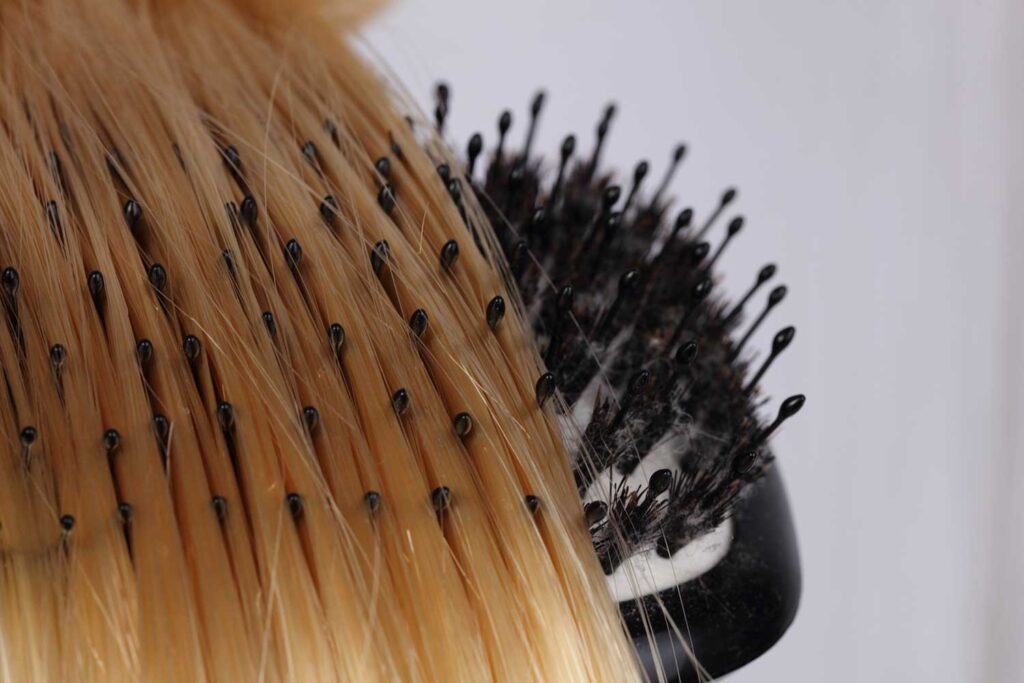
Dealing with Emotional Impact
Coping with the Frustration of Shedding
Dealing with shedding in a human hair wig can be frustrating and emotionally challenging. It is important to acknowledge and address these emotions to maintain a positive outlook and confidence in your wig.
Allow yourself to feel frustrated or upset about shedding, but remember that it is a common issue faced by many wig wearers. Remind yourself that shedding is manageable, and there are solutions available to address the issue.
Seek support from friends, family, or online communities, as sharing your frustrations can provide a sense of relief and understanding. Speaking with others who have experienced similar shedding issues can offer valuable insights, advice, and encouragement.
Building Confidence Despite Wig Shedding
Shedding in a human hair wig does not define your style or your identity. Building confidence despite shedding involves embracing your wig as a tool for self-expression and finding alternative solutions to boost your confidence.
Experiment with different hairstyles, colors, and accessories to create new looks and styles. Focus on enhancing your natural beauty and personal style through your wig, rather than allowing shedding to dampen your confidence.
Remember that shedding is a temporary issue and does not reflect your worth or beauty. By adopting a positive mindset and embracing the versatility of human hair wigs, you can continue to exude confidence and radiate beauty.
Finding Support from Others in Similar Situations
Finding support from others who are going through similar shedding issues can provide a sense of comfort, understanding, and camaraderie. Joining support groups, online forums, or social media communities can connect you with individuals who can relate to your struggles and offer valuable advice and encouragement.
Listen to the experiences and stories of others, share your own journey, and provide support to those in need. Establishing these connections can help to alleviate feelings of isolation and empower you to overcome shedding challenges.
Exploring Additional Hair Loss Solutions
If shedding in your human hair wig continues to be an ongoing issue, you may consider exploring additional hair loss solutions. Consult with a dermatologist or a hair restoration specialist to discuss potential treatments or therapies that can address the underlying causes of shedding.
Hair loss solutions can range from regrowth treatments to scalp therapies or medications. By addressing the root cause of shedding, you may be able to minimize or eliminate the issue altogether.
Remember that there are various options available, and it is important to choose a solution that aligns with your personal needs and preferences. Seek professional guidance and thoroughly research any hair loss solutions before pursuing them.
Final Thoughts and Conclusion
Shedding in a human hair wig can be a frustrating and challenging issue, but with proper care, maintenance, and understanding, it can be effectively managed. By following the tips and techniques discussed in this article, you can minimize shedding, maintain the quality and appearance of your wig, and confidently rock your desired hairstyle.
Remember that shedding is a natural process, and some hair loss is to be expected. However, excessive shedding may require further attention and intervention. Consult with professionals, join online communities, and seek support to address shedding issues and find suitable solutions for your human hair wig.
Human hair wigs offer endless possibilities for personal style, hair loss solutions, and self-expression. With the proper care, maintenance, and a positive mindset, you can confidently embrace the versatility and beauty of human hair wigs, shedding your worries about shedding along the way.
